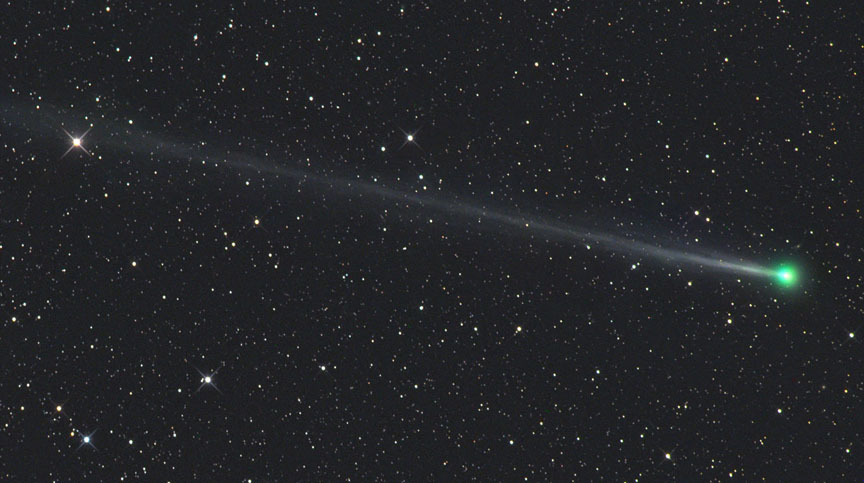
Merry Christmas and Happy Holidays all! I hope the day finds you in the company of family or friends and feeling at peace. While we’ve been shopping for gifts the past few weeks, a returning comet has been brightening up in the evening sky. Named 45P/Honda-Mrkos-Pajdusakova, it returns to the hood every 5.25 years after vacationing beyond the planet Jupiter. It’s tempting to blow by the name and see only a jumble of letters, but let’s try to pronounce it: HON-da — MUR-Koz — PIE-doo-sha-ko-vah. Not too hard, right?
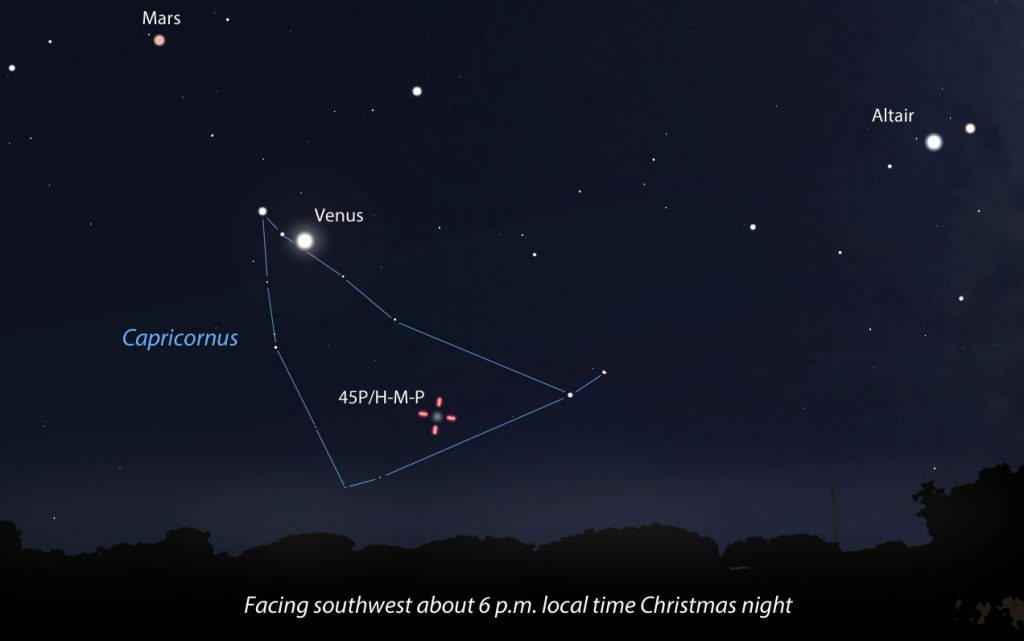
Comet 45P is a short period comet — one with an orbital period of fewer than 200 years — discovered on December 3, 1948 by Minoru Honda along with co-discoverers Antonin Mrkos and Ludmila Pajdusakova. Three names are the maximum a comet can have even if 15 people simultaneously discover it. 45P has a history of brightening rapidly as it approaches the sun, and this go-round is proof. A faint nothing a few weeks back, the comet’s now magnitude +7.5 and visible in 50mm or larger binoculars from low light pollution locations.
You can catch it right around the end of dusk this week and next as it arcs across central Capricornus not far behind the brilliant planet Venus. 45P will look like a dim, fuzzy star in binoculars, but if you can get a telescope on it, you’ll see a fluffy, round coma, a bright, star-like center and perhaps even a faint spike of a tail sticking out to the east. Time exposure photos reveal a tail at least 3° long and a gorgeous, aqua-tinted coma. I saw the color straight off when observing the comet several nights ago in my 15-inch reflector at low power (64x).
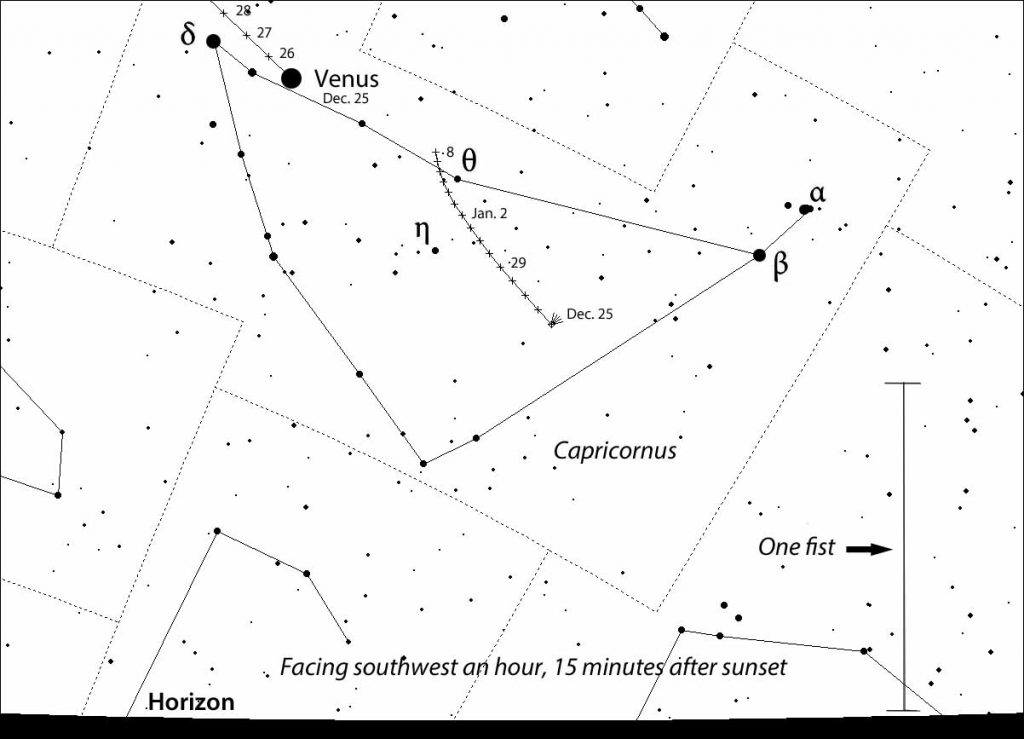
Right now, and for the remainder of its evening apparition, 45P will never appear very high in the southwestern sky. Look for it a little before the end of evening twilight, when the sky is reasonably dark and the comet is as high as it gets — about a fist above the horizon as seen from mid-northern latitudes. That’s pretty low, so make the best of your time. I recommend you being around 1 hour 15 minutes after sunset.
The further south you live, the higher 45P will appear. To a point. It hovers low at nightfall this month and next. That will change in February when the comet pulls away from the sun and makes a very close approach to the Earth while sailing across the morning sky.
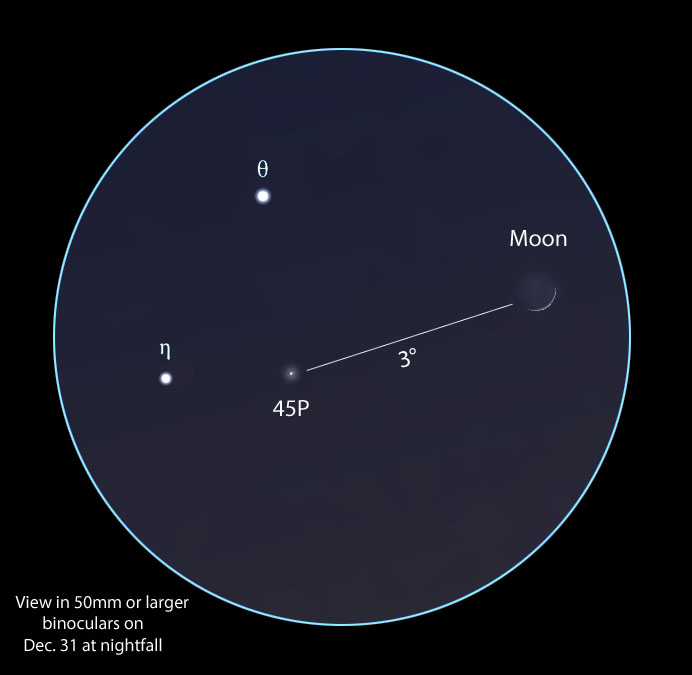
45P reaches perihelion or closest distance to the sun on Dec. 31 and will remain visible through about Jan. 15 at dusk. An approximately 2-week hiatus follows, when it’s lost in the twilight glow. Then in early February, the comet reappears at dawn and races across Aquila and Hercules, zipping closest to Earth on Feb. 11 at a distance of only 7.7 million miles. During that time, we may even be able to see this little fuzzball with the naked eye; its predicted magnitude of +6 at maximum is right at the naked eye limit. Even in suburban skies, it will make an easy catch in binoculars then.
I’ll update with new charts as we approach that time, plus you can check out this earlier post by fellow Universe Today writer David Dickinson. For now, enjoy the prospect of ‘opening up’ this cometary gift as the last glow of dusk subsides into night.

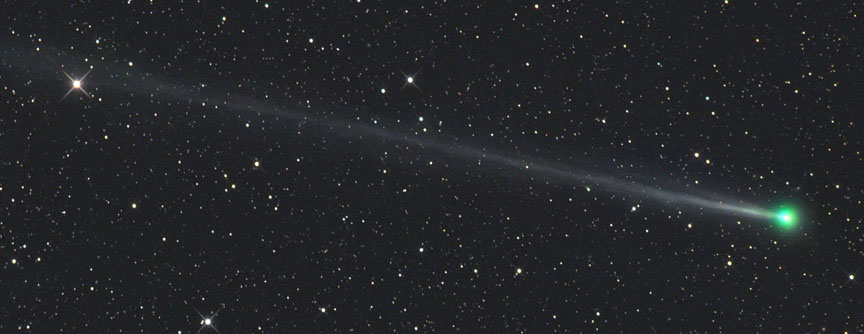
WAY cool! If I get a chance to observe this comet, it will be my 53 sighting! YES.. am on the prowl!
The wife asked me what I wanted for Christmas so I mentioned I need/wanted a new pair if binoculars.. preferably larger. She admitted that she had no clue as to what I was asking for… so she had me look it up on the i-net then bought it! Cool beans at a BAR-B-Que!
Bottom line? How’s a 15X70mm Skywatcher by Celestron sound? The package from B&H got here a week ago and I’ve been chomping at the bit ever sense! It got wrapped and put under the tree… for a WHOLE WEEK! The box got opened last night, x-mas eve.
Tay.. to keep from going totally bonkers while I WAITED, I checked out a bunch of reviews about it. ONE YouTube video showed how to rip off the rubber grip and adjust the prisms with a screw driver… the process destroys that cover. The author complained that he saw double stars everywhere he looked, so this collimation fix is what he came up with. (Lives Australia & didn’t want to ship it for repairs.. so he did it himself) MY pair are clean that way with sharp star images. THEN I tried to screw in the photo tripod mount… the threads did not work! Tay… I had to tap out the 1/4-20 thd in the brass adapter mounting… allies goot! Put the mount on and noticed that due to it’s curved structure, the front of the binocs was WAY heavy… So I pulled the snap ring holding the mounting screw, flipped it over and put the snap ring back on. THAT put the CG in the middle where it’s SUPPOSED to be! Made in China for Celectron.. methinks the build dint translate well.. An easy enough fix if you are handy?
BOTTOM line is that I will use it on this comet! (Cod willin and it don’t cloud up again!)
Aqua,
Wow, those are some alterations! Sounds like you’re good to go now. If you see the comet, let us know. Thanks!
Went out to the coast for a clear western horizon.. As the sun set.. a band of clouds approached then blocked the view.. dzz. Typical winter weather… out? Maybe tonight?
Have not had any such trouble with my Celestron 15X70 bins. I fact i was able, once, to handhold them on the ISS when it was flying over my home. It looked odd so I checked with NASA and discovered that at that moment the Shuttle was going around the ISS to have its tiles checked! So a while ago now.
However the same bins will be checking out 45P, P stands for periodic, given clear skies and as I live almost as south as it possible to be in the UK I do at least stand a chance.
Happy New Year – Roseland Observatory.
Good luck, Brian. Please let us know if you succeed in spotting the comet. Thanks!